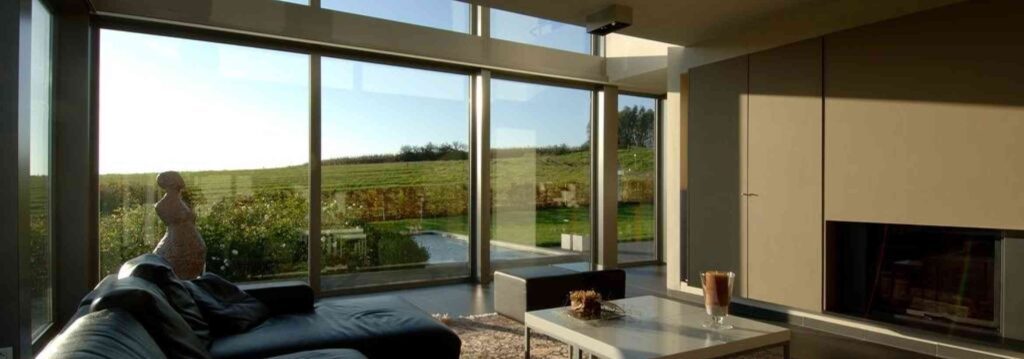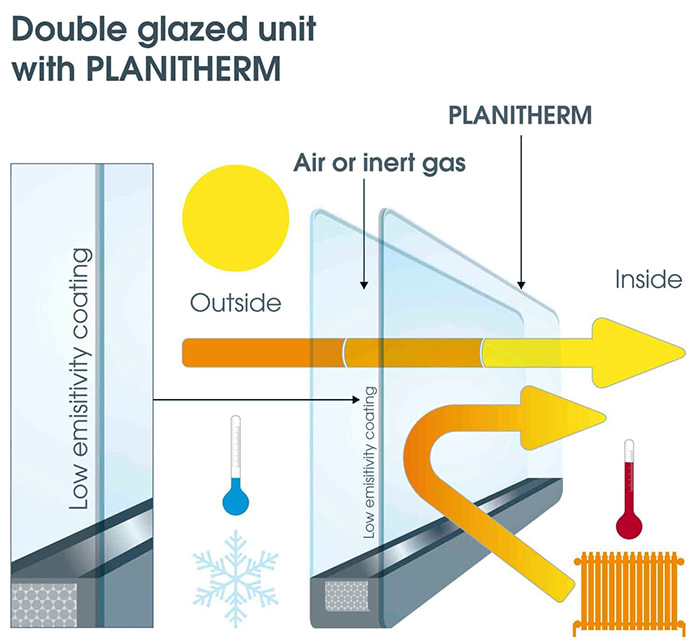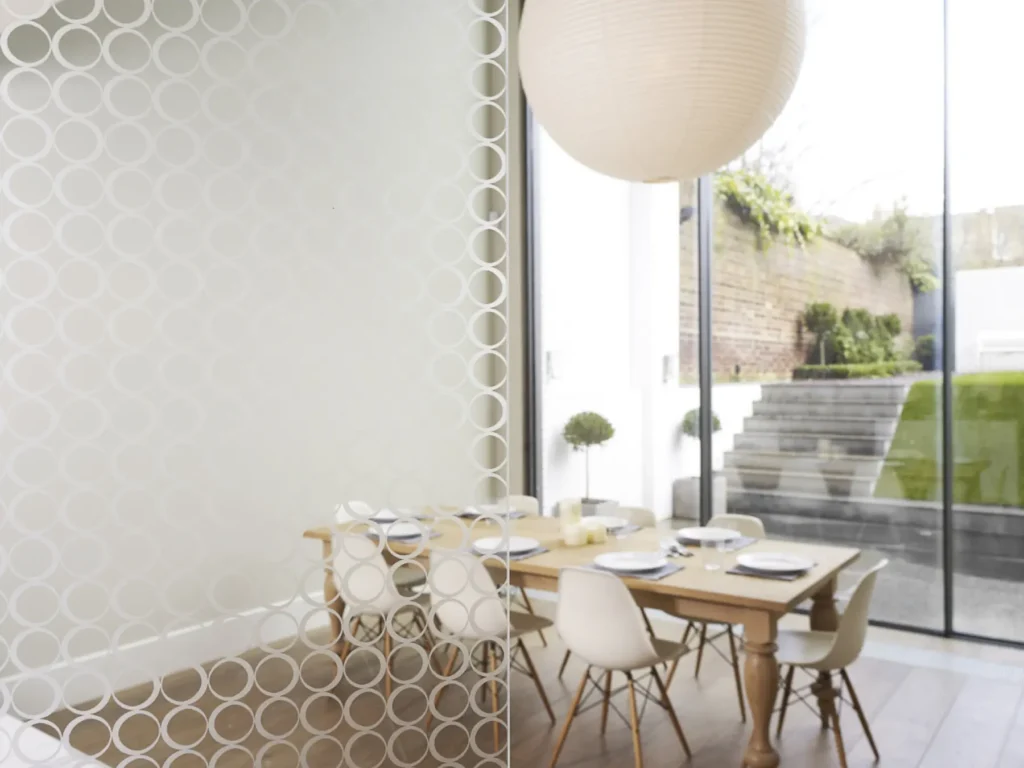Table of Contents
According to The Energy Trust, as much as 26% of all the heat lost in the average home escapes through windows and other glazed areas. Some of this heat loss relates to poor insulation or damaged frames. However, the kind of glazing you have can also significantly affect how much heat escapes your home.
The most energy-efficient glass on the UK market is Planitherm glazing. Specifically created to tackle heat loss and reduce carbon emissions in modern homes, these innovative coated windows promise to dramatically lower heating bills and carbon footprints. But are they worth the money?
With over 25 years of experience producing and installing myriad types of glazing, the expert team at Manchester Window Factory is ideally placed to advise you on the best glazing options to suit your needs.
In this blog, we will explain what Planitherm windows are, how they work, and the pros and cons of installing Planitherm glazing in your home.
What are Planitherm windows?
Planitherm glass windows have a thermally insulating coating acting to retain heat and reduce emissions. This type of window is also called low-emissivity glass (low-E glass).
Although other types of energy-efficient windows are available, Planitherm windows are UK market leaders in energy-efficient glazing. Developed specifically for the UK climate, these high-performance windows and door glazing can be double or triple-glazed.

Different types of Planitherm windows
Several types of Planitherm glass windows are available, including safety glass, acoustic glass, obscure glass and solar-controlled glass.
However, there are three primary ranges of Planitherm glass – Energy Standard, Comfort, and Comfort Plus, all of which can be used with double or triple-glazed windows.

Planitherm Energy Standard
The most basic option is the Planitherm Energy Standard double-glazed window. This unit features the unique Planitherm thermal coating on the inner pane, combined with argon-filled gaps and warm edge spacer bars to create an energy-efficient, A-rated window. Planitherm Energy Standard reduces heat loss by around 56% compared to an uncoated double-glazed window.
Planitherm Comfort
If noise pollution or security is a concern, you should consider the Planitherm Comfort unit. These clever windows have an extra transparent layer built in, reducing noise transmission by approximately 20% compared to standard double-glazing. The extra layer of 6.8mm STAPID SILENCE laminated glass on the exterior pane also increases privacy and security.
Planitherm Comfort Plus
Last but by no means least, we have Planitherm Comfort Plus. A 16mm window, it features a 90% argon-filled space with a centre-pane u-value of 1.0w/m2k. The best option for customers with large glazed areas, particularly if they are south-facing, these windows combine all of the energy efficiency, noise reduction, privacy and security benefits of its sister products. The low-E glass retains 63% more internal heat while blocking 50% of the sun’s harmful UV rays, reducing emissions and creating a pleasant internal temperature all year around.
Key Benefits of Planitherm Windows
Planitherm windows offer all the benefits that come with standard double or triple glazing to UK homeowners, plus:
- The special coating works to stop heat escaping through the glass for warmer rooms, reducing heating bills and lowering your carbon footprint.
- The coating allows natural daylight to penetrate, creating bright and inviting spaces.
- The heat generated also warms rooms to create a comfortable temperature.
- 50% – 99% of the sun’s harmful rays are blocked, depending on the glazing chosen.
- The coating further toughens glass for enhanced security.
- It also offers up to 20% better protection from ambient sounds.
- Planitherm Comfort Plus can control the level of external heat penetration.
- There is less furniture fade thanks to the coating acting as a barrier to the sun.

Technical Specifications
Performance Data | Double-Glazed Unit | Triple-Glazed Unit |
Internal Pane | SGG PLANITHERM ONE T | SGG PLANITHERM ONE T |
External Pane | SGG PLAINICLEAR SGG DIAMANT | SGG PLAINICLEAR SGG DIAMANT |
Composition in mm | 4(16)4
| 4(16)4(16)4 |
Coating Position | Face 3 | Face 3/5 |
Light Transmission | 81% | 72% 73% |
Light Reflectance | 12% | 16% |
LRi | 13% | 16% |
g-value | 0.73 0.75 | 0.63 0.64 |
Shading Coefficient | 0.83 0.86 | 0.72 0.74 |
U-valua in W/m2K** – Air | 1.4 | 0.8 |
90% Argon | 1.2 | 0.6 |
The energy efficiency of windows is measured using a u-value. The lower the u-value, the more energy-efficient the product is. The u-value is partly determined by how much heat can escape through the glass. However, gas-filled gaps and spacers also determine how energy efficient the window is, so look at the window’s overall energy rating.
Planitherm glass windows have a u-value of 1.1, with the Planitherm Comfort Plus windows having a u-value of just 1.0 making them ultra energy efficient.
They are an eco-friendly product, with the carbon used to manufacture one square metre of Planitherm glass recovered in 10.5 months with single-glazed windows and just 3.5 months for double-glazing.
The Planitherm coating is typically on either the second or third face of a double-glazed unit, facing the cavity to prevent damage from the external atmosphere.
The coating is permanent and hermetically sealed within the glass unit to last the window’s lifespan. It is also invisible to the naked eye, so it won’t alter the appearance of your windows.

Comparing Planitherm with Other Glazing Options
Feature | Planitherm Windows | Standard Double Glazing | Triple Glazing |
Energy Efficiency | High | Moderate | Very High |
U-Value (Lower is Better) | Low (typically 1.0 – 1.2 W/m²K) | Higher (1.5 – 3.0 W/m²K) | Very Low (0.8 – 1.0 W/m²K) |
Solar Gain | Moderate | High | Low |
Thermal Insulation | Excellent | Moderate | Superior |
Glare Reduction | Good | Moderate | Excellent |
Noise Reduction | Moderate | Low | High |
Security Features | Advanced | Basic | Advanced |
Cost | Mid-range | Lower Cost | High Cost |
Availability | Widely Available | Commonly Available | Less Common |
Ideal Use Case | Residential & Commercial | Budget-conscious homeowners | Cold Climates & Noise Reduction |
Pros and Cons of Planitherm Glass Windows
There are many advantages and only a few potential drawbacks to installing Planitherm glass windows in your home or commercial premises.
Pros
- Highly energy efficient
- Reduces carbon emissions
- Reduces drafts
- They save you money on your heating bills
- The coating lasts the lifespan of the window
- Green product –
- Helps maintain temperature control
- Can be used in a wide range of windows, doors and conservatories
- Difficult to break for better security
- Help reduce noise pollution transmission
- Reduces condensation on internal glass
Cons
- Not as effective for larger south-facing windows
- Condensation can form on the exterior
- Planitherm windows can be more expensive than standard double-glazing

Installation Process
At Manchester Window Factory, we employ in-house fitters, licenced to install Planitherm glass. We’re happy to support you through the process, from initial consultation to final fitting.
As noted above, Planitherm glazing is compatible with most window frames, so you can either have new windows fitted from scratch or replace the original glazing with Planitherm.
Either way, our professional fitters can complete the job and issue you with FENSA certificates, which you may need if you want to sell your house in the future.
Planitherm is installed the same as standard double or triple-glazing.
Once we have taken measurements and helped you create your ideal windows, we will arrange a convenient time with you to perform the installation.
Depending on the time of year, the number of windows, access, and the complexity of the job, we will typically complete the installation in a day.
In the winter, we usually fit fewer windows as we don’t want to leave you with holes in your walls while we work.
There is some unavoidable mess involved, so prepare your home to minimise disruption. We try to be as tidy as possible and work from outside whenever feasible.
Conclusion
Specifically designed for UK homes, Planitherm low-E glass windows are an eco-friendly solution to poorly insulated properties.
The unique coating enhances every aspect of your window, from energy efficiency and heat retention to acoustic performance and security.
Planitherm glazing is available for every type of window, door and conservatory.
Whether you are eco-conscious or feeling the pinch of high heating bills, you may want to consider installing energy-efficient windows such as Planitherm glass windows.
If your budget allows, Planitherm is the most energy-efficient glazing and offers a high return on investment, saving you money and potentially increasing your property value.
So, there you have it, our quick guide to Planitherm windows and why they are becoming the new energy-efficient standard.
To discuss your upgrade to Planitherm windows with one of our in-house experts, please get in touch. We look forward to hearing from you!
How to Get in Touch
If you want to find out more about creating customised windows, doors, and conservatories, please don’t hesitate to get in touch. You can call us on 0161 976 4739, use our contact form or chat with us via the chat button at the bottom right of this website. If you live locally, you can also visit our Altrincham showroom, and check our contacts page for up-to-date opening hours.
We look forward to hearing from you!
FAQs
Similar to self-cleaning glass, Planitherm glass is made by applying a unique coating. Whereas the titanium oxide on self-cleaning glass windows is designed to repel oil and water, the coating on Planitherm glass controls the heat.
The neutral thermal coating which gives Planitherm glass its name allows some of the heat from the sun to penetrate the glass while blocking harmful UV rays. Planitherm glass also reduces draughts, a huge help in keeping your home comfortable in the winter months.
This process not only helps to keep the heat in your rooms where it belongs but also reduces the harmful emissions that are contributing to the climate crisis. Hermetically sealed to the glass, the Planitherm coating is guaranteed to last the lifespan of the window. That means you will never need to repair or replace the coating until it’s time for new windows.
The higher the degree of heat loss, the less energy efficient your windows are and the more you will have to spend to ensure your home or office maintains a comfortable temperature. In a nutshell, if your windows are not properly insulating, you will need to put your heating on more often and at a higher setting.
Planitherm windows are proven to reduce heat loss, making your home more energy efficient. They use the sun’s natural heat and light to warm and brighten your home and are an excellent choice in the battle to make UK homes more energy-efficient.
There is also the concern about the emissions which poorly insulated windows give out. Because you don’t need to put the heating on as high or as often, you are also putting fewer emissions out in the atmosphere.
The Glass and Glazing Federation and The Energy Trust estimate that the average three-bedroom house could save around £340, 22% per year on their heating bills.
As mentioned, Planitherm has been designed specifically to deal with the changeable UK climate, and the battles the country faces in the quest for energy-efficient homes.
Not only is it the market leader in the UK, but it is also the best-selling low-E glass in Europe.
Usually, window installation or replacement is covered by building regulations. However, if you live in a conservation area or you live in a listed building, you may need planning permission. If you have an Article 4 direction on your property, you will not be able to make any changes.
Condensation on the inside of windows occurs primarily due to high internal humidity combined with a low external temperature. This means when you heat your home against the cold, you could end up with condensation on the inside of your windows.
Planitherm glass reduces the possibility of condensation forming internally, by restricting the heat passing through the two panes of glass. The low-E coating also helps to control the internal temperature.
Condensation can also form on the exterior of your windows. This is due to the temperature of the glass dropping below the outdoor dew point temperature. Because thermally-insulated windows such as Planitherm reflect the heat inside, the outer glass does not warm up as much as less thermally-efficient windows. Condensation can therefore form on the exterior of the window.
As the coating is within the glass, it does not require special maintenance. You can clean your Planitherm windows with a gentle window cleaner or warm soapy water and a microfibre cloth. External condensation should dissipate naturally, but you can also wipe it off if it bothers you. Other than that, it will just be regular maintenance appropriate to the material of the frame and the style of the window.




